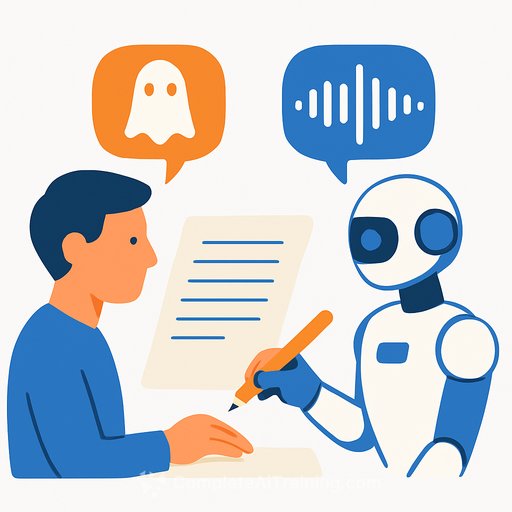AI Is Redefining-and Challenging-the Craft of Writing
Artificial Intelligence has become the ghostwriter of our era. Essays, emails, news articles, even books-spun up in minutes, clean and coherent. For working writers, this feels like a pressure valve finally opened.
It breaks creative stalls, speeds up research, and helps translate tone across audiences and languages. In short, it democratizes access to clear prose and gives you time back. The question isn't "Should I use it?" The question is "How do I use it without losing my voice?"
What AI Gives Working Writers
Used well, AI compresses the timeline from idea to publish-ready draft. It handles the repetitive parts so you can focus on the pieces that pay: angle, insight, and voice.
- Idea generation: Explore angles, headlines, and structures fast.
- Research synthesis: Summarize long sources into workable notes (then verify).
- Tone translation: Adapt voice for clients, regions, and reading levels.
- Draft acceleration: Turn outlines into first drafts you can rewrite.
- Format and SEO scaffolding: Create briefs, FAQs, and schema-ready sections.
- Language support: Help non-native writers communicate with clarity.
The Risks No Pro Should Ignore
Convenience can flatten originality. Heavy dependence drifts toward a polished-but-empty tone. If you're not careful, the tool erodes the very edge clients hire you for.
- Voice erosion: Your cadence and perspective get replaced by generic fluency.
- Shallow thinking: You accept surface summaries and stop wrestling with ideas.
- Authorship and credit: Who owns what-and what do you disclose?
- Misinformation risk: Confident prose that's factually off can slip through.
- Academic and client integrity: Deliverables may cross lines without clear policy.
A Practical Workflow That Keeps Your Voice
Use AI as an accelerator, not a substitute. This simple loop keeps you in control while still saving hours.
- Brief: Define audience, promise, POV, and non-negotiable sources. Write this yourself.
- Outline: Ask AI for 2-3 outlines from your brief. Merge, don't accept blindly.
- Anchor paragraphs: Write the thesis, key transitions, and conclusion in your voice.
- Assist: Let AI expand supporting sections and tighten structure around your anchors.
- Fact audit: Verify every claim with trusted sources. Replace shaky lines.
- Voice pass: Read aloud. Add your quirks, tension, and specific examples.
- Originality check: Do a quick web search for close matches. Rewrite anything too familiar.
Guardrails for Ethics and Trust
Trust is your competitive moat. Set clear rules so clients know your process is solid.
- Disclose use when appropriate: If AI assisted meaningfully, say so in your contract or process notes.
- Cite real sources: Link to authoritative material for stats and claims.
- No hallucinated quotes or studies: Verify text against the original source every time.
- Protect client data: Don't paste sensitive info into public tools.
- Keep a changelog: Track where AI assisted and where you rewrote.
For newsroom-level standards, see the Associated Press guidance on generative AI use here. For copyright questions around AI, WIPO provides a solid overview here.
Make AI Your Intern, Not Your Co-Author
Think of AI like a sharp intern: great at pulling threads, drafting options, and tidying language. You set direction, make the hard calls, and sign your name.
That means you own the brief, the thesis, and the final pass. If a sentence doesn't sound like you, rewrite it until it does.
Quality Controls That Don't Slow You Down
- Two-source rule: Important facts need at least two credible references.
- Proof of read: Run a human read-aloud pass before delivery.
- Client constraints: Lock tone, style, and banned phrases up front.
- Final author check: Ask, "Would I say this in a meeting?" If not, adjust.
What to Measure
If it doesn't improve outcomes, it's noise. Track the basics and tune your process.
- Time saved per piece without quality loss.
- Acceptance rate on first drafts.
- Reader signals: retention, clicks on key sections, replies.
- Corrections per article (aim down and to the right).
Tool Use Without Losing the Craft
Use ChatGPT or similar tools to brainstorm, structure, and clean prose. Keep research sources open in separate tabs and cite them directly-never cite the model.
Maintain a personal voice bank: favorite phrases, sentence rhythms, analogies, and stories. Feed that into your drafts so the texture stays yours.
Simple Team/Freelance Policy
- Allowed: Outlines, drafts of non-sensitive sections, edits for clarity.
- Required: Human fact-checking, source citations, final voice pass.
- Prohibited: Sensitive data input, fake quotes, invented sources.
- Disclosure: Share AI use on request; list where it assisted.
Keep the Edge: Train Your Process
Your advantage isn't the tool-it's how you use it. Build a repeatable workflow that compounds across clients and formats.
If you want structured options for sharpening your AI workflow as a writer, explore AI tools for copywriting and courses by job to level up specific skills.
AI can assemble sentences. Writers create meaning. Keep that hierarchy intact, and you'll ship faster work that still sounds like you-and stands up under scrutiny.
Your membership also unlocks:






